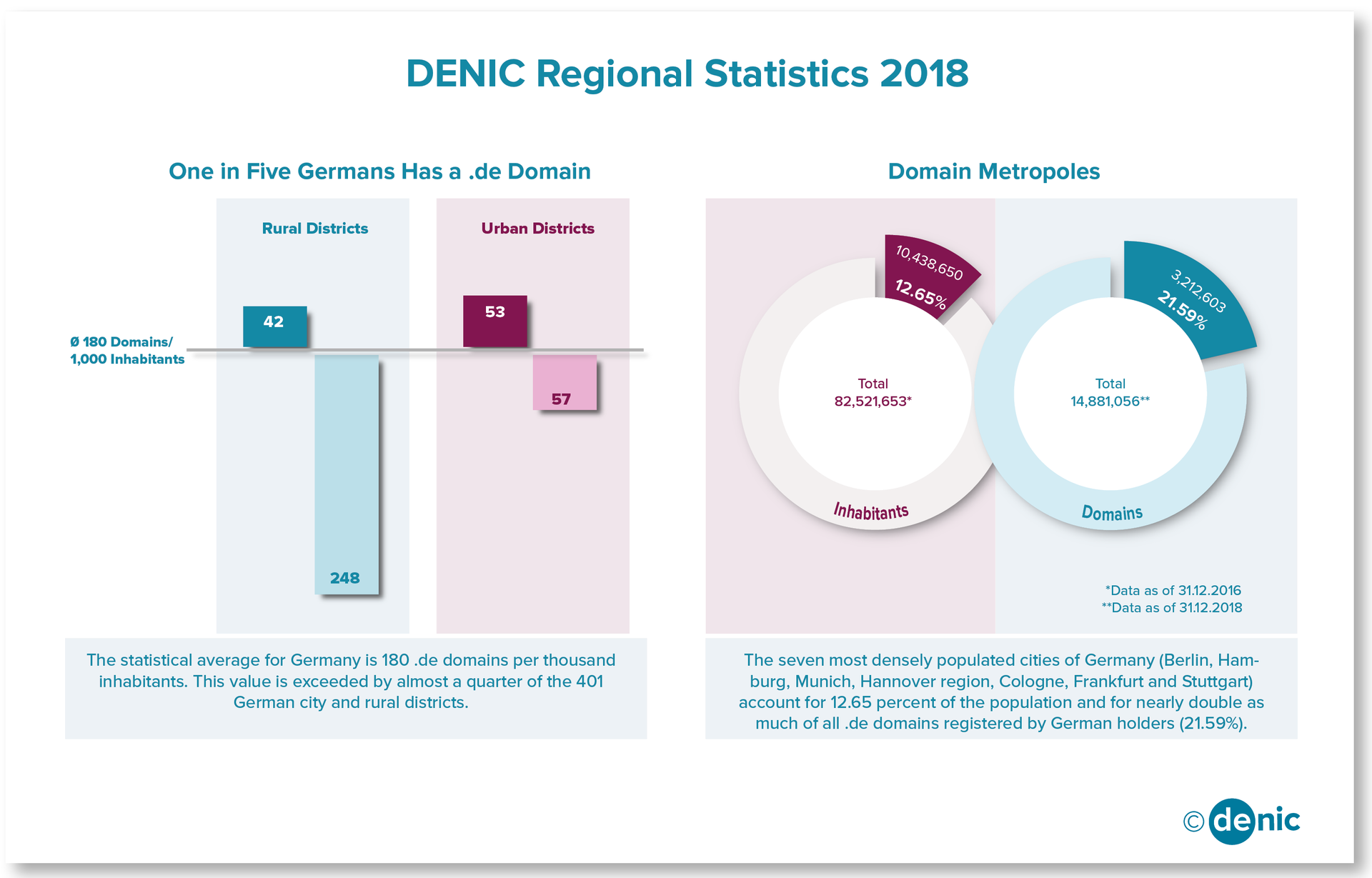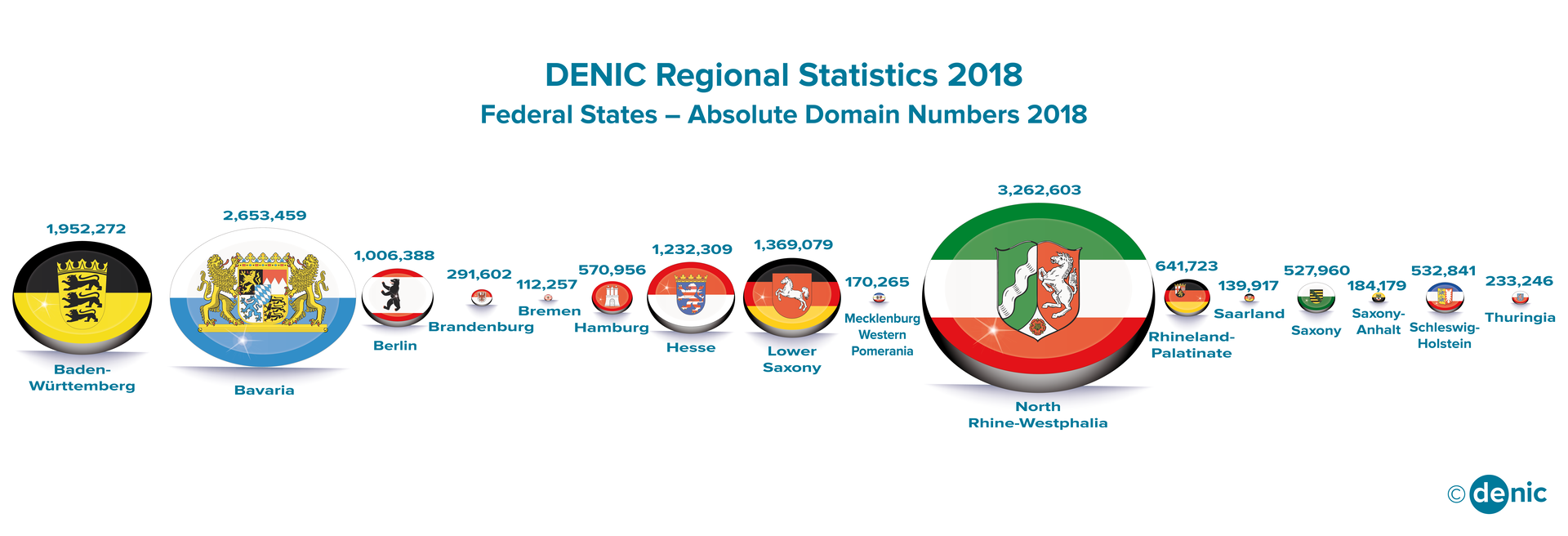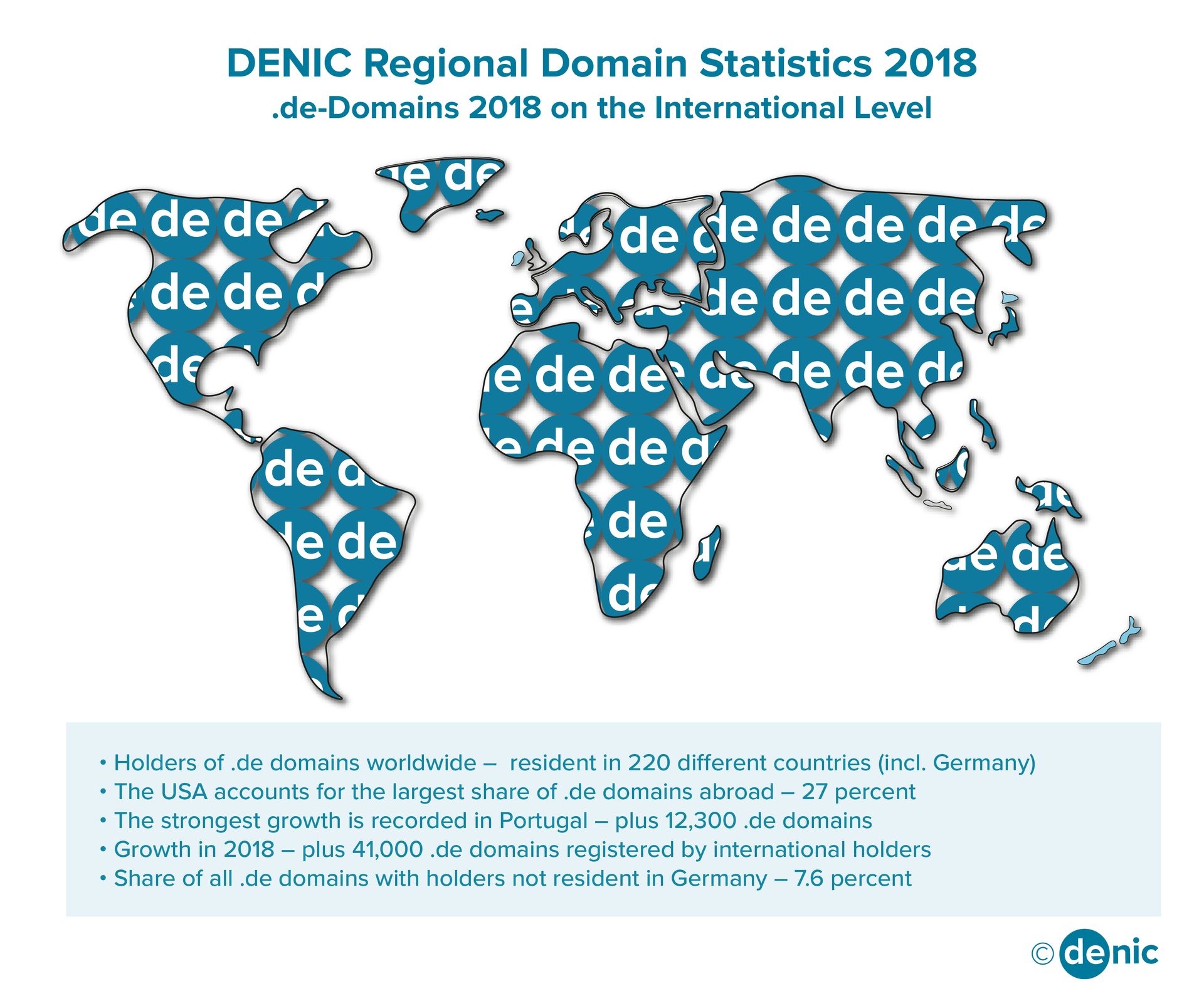Every year, the precise geographic distribution of .de domains is mapped in the annual regional domain statistics published by DENIC. The registry managing all domains with the ending .de now presents the results of 2018. As of 31 December 2018, nearly 15 million .de domains were regis-tered in the 401 cities and districts of Germany. Adding to these numbers are more than 1.2 million domains of holders whose place of residence is abroad. In total, more than 16.2 million .de do-mains were registered at the end of 2018. For the first time since .de domains were launched in 1986, the total number of registrations in Germany displayed a slightly downward trend. The num-ber of .de domains with holders resident outside Germany, in contrast, continued to rise in 2018.
Municipal Level: Urban .de Domain Registration Clearly Exceeds Numbers in Rural Areas
Looking at absolute domain numbers, the top ranks among German cities continued to be held by the metropolitan places: Scoring 1,006,388 .de domains, Berlin stays clearly in the lead, far ahead of Munich (623,494) and Hamburg (577,127) on ranks two and three. When referring the number of .de domains to the number of inhabitants, last year's ranking of the top three in that group also remains unchanged. Osnabruck comes first again: With 1,509 .de domains per 1,000 inhabitants, it still is far ahead of the other two top runners in the city league, Munich (426) and Bonn (388). In regard to the administrative districts, the frontrunners are located in the South of Germany again, namely Bavaria: Freising (435 domains) remains the uncontested number one, preceding the dis-tricts of Starnberg (398) and Munich (366). The national average is 180 .de domains per 1,000 in-habitants (higher individual statistical values reflect local domain investors with larger-scale domain portfolios). About one quarter of the cities and districts included in the analysis exceed the aver-age value, whereby the number of cities (53) with above-average values is considerably higher than the number of districts (42).
Regional Level: West German Year-on-Year Domain Development Outscores East German Domain Evolution
The ranking on the federal-state level for the number of domains related to inhabitants also showed consistency in 2018. The state of Hamburg – comprising the city of Hamburg and its wid-er outskirts – with 315 domains per 1,000 inhabitants maintains its uncontested leading position and stays far ahead of Berlin (282) and the state of Bavaria with its vast lands (205). As in the pre-ceding year, the state of Saxony-Anhalt (82) brings up the rear after the states of Mecklenburg-Vorpommern and Thuringia with 106 and 108 domains per 1,000 inhabitants respectively. Moder-ate domain growth was recorded in the South of Germany with increases of 0.4 percent for Bavar-ia, 0.3 percent for Hesse and 0.1 percent for Baden-Württemberg. For the first time ever, the over-all national growth rate (-0.9%) fell short of last year's result (2017: +1.05%). The most pronounced deviations from the average value were recorded for Schleswig-Holstein (-9.1%), Sachsen-Anhalt (-2.0%) and Lower Saxony (-1.6%). Excluding Berlin (-0.4%), the average percentage domain growth among the states in the West of Germany (-0.9%) is slightly higher than that of those in the East (-1.1%). Related to absolute numbers, the so-called Free State of Saxony with 527,960 registered .de domains achieved the highest density among the federal states in the East of the country and scored ten again in the overall German ranking. North Rhine-Westphalia (3,262,603 domains) and Bavaria (2,653,459 domains) remain on ranks one and two.
International level: Popularity of .de Beyond German Borders Continuously on the Rise
Compared on an annual level, the overall number of .de domains under management decreased slightly by 0.7 percent compared to a 1.2-percent increase in 2016/2017. This is a decline of 110,000 .de domains (previous year: plus 200,000 domains). The 16.2 million .de domains that were registered at the end of 2018 included 1,225,965 domains of holders residing outside of Germany (2017: 1,185,247). Contrary to the development of .de domains registered by holders re-siding in Germany, the number of domains with holders from abroad increased by 3.4 percent and accounted for 7.6 percent of all .de domains at the end of 2018. The holders of .de domains origi-nate from 219 countries. As in the past, German domains are particularly popular in the United States (27%), the Netherlands (10%) and in the Russian Federation (7%). But Ger-many's European neighbours Switzerland, Austria and Great Britain, and also the United Arab Emirates account for 6 percent respectively of the .de domains with non-German-based holders, too. All in all, 16,204,745 domains were registered with DENIC on 31 December 2018. Statistically, every fifth inhabitant of the Federal Republic of Germany has registered a domain under the TLD .de. Thus, Germany consistently ranks fourth in the world after the Netherlands, Switzerland and Denmark.
Detailed online data available
You find comprehensive data and graphic material as well as the complete regional analysis in form of an Excel file for all the 401 cities and districts in the statistics section of the DENIC website. We also make available the annual analyses since 1995. In addition to absolute values, the statistics provide data on the number of domains related to the number of inhabitants, complemented by maps and diagrams showing the absolute and the relative distribution of domestic domains as well as of domain holders residing outside of Germany.



